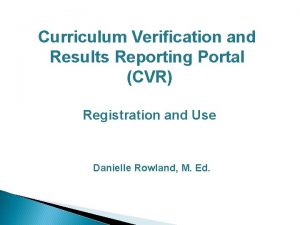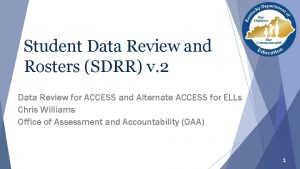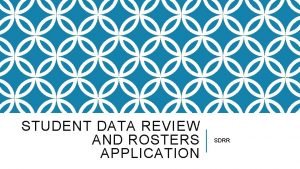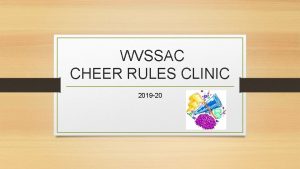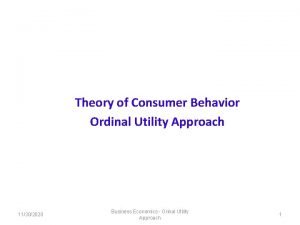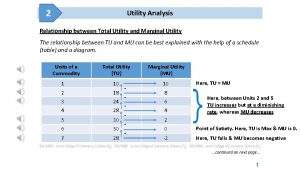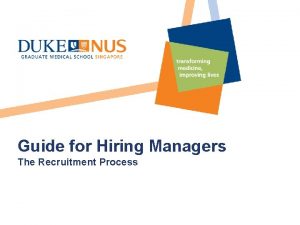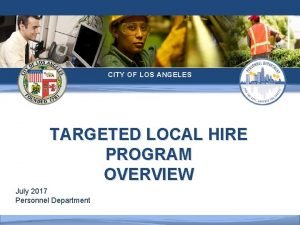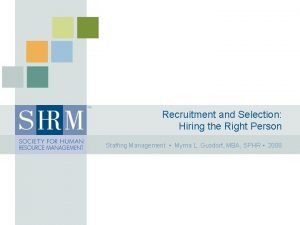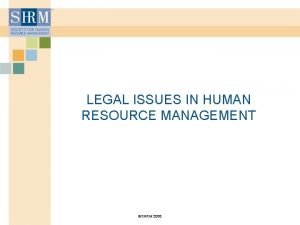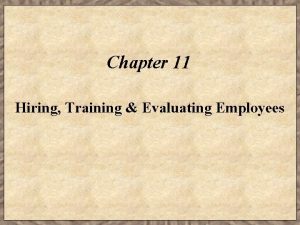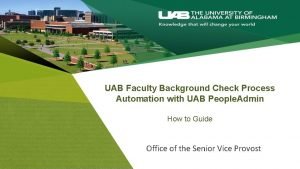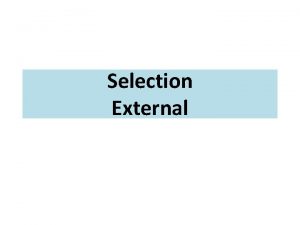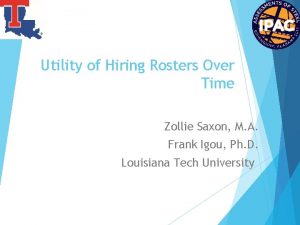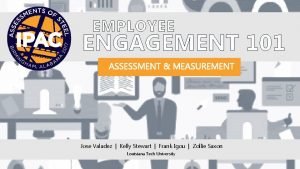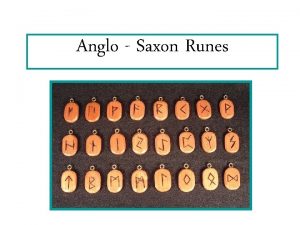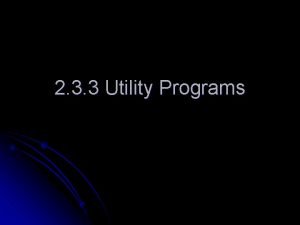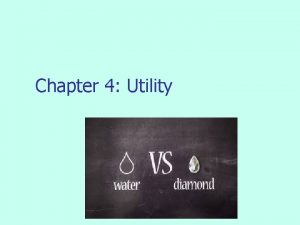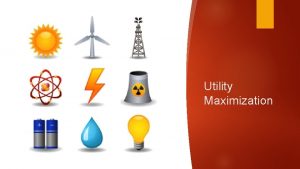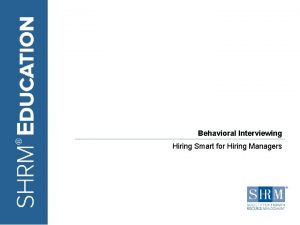Utility of Hiring Rosters Over Time Zollie Saxon



















- Slides: 19

Utility of Hiring Rosters Over Time Zollie Saxon, M. A. Frank Igou, Ph. D. Louisiana Tech University

Overview The Basics of Selection Tests and Eligibility Rosters Why do we care about temporal utility? Limitations Data of the status quo Simulations Summary and Implications

The Basics Valid Selection Tests: Used to create eligibility rosters Increases the likelihood of hiring high performers Increases the likelihood that people will be treated fairly during hiring decisions are made Can reduce unfair discrimination by using “fair” job-related discrimination Can reduce the likelihood of unfair discrimination lawsuit

Valid Selection Tests Eligibility rosters list names of candidates in rank order of test scores Selection tests are necessary, but comes with a price $$$ However, if selection tests are less expensive than utility loss why not test more frequently? Hiring roster utility determined by predicted job performance & salary

In This Brief Simulation We Examined Time Attrition & Hire Effects Utility Analysis Including these Effects How utility analysis may be used to determine when it may be best to test again rather than continue to use an eligibility roster

Data The Monte Carlo data used in this simulation is based on parameters from a multiple-choice test used to entry-level law enforcement selection procedure for a medium size city (population 250, 000 to 500, 000) located in the Southern United States.

The Simulation In a real police selection procedure, it would take time to process job candidates through the following steps. Background Check Psychological Screening Medical Screening Physical Abilities Test Polygraph Test Law enforcement agencies often report that background checks can be the most time consuming, often taking several weeks or more to complete

The Simulation Test scores used in simulation were z scores Scores presented are civil service scores (z score x 10 + 70) 221 Candidates who scored about the cutoff point; assumes a total of approximately 320 examinees

The Simulation 48 Total Selections Made in Intervals of 8 Time Frame: 6 Months Predicted Attrition: 5%/Month Plus Previously Hired Applicants

The Brogden-Cronbach-Gleser Utility Formula One of the most widely used utility formulas in recruitment and selection This formula quantifies utility of a selection system in terms of Dollars

The Brogden-Cronbach-Gleser Utility Formula Quality U = (Ns)(T)(SDy)(rxy)( Zx) – C(Napp) Quantity U = Change in Utility Ns = Selected Applicants T = Average Tenure SDy= $ Value Performance Difference Cost rxy = Correlation Between Selection & Performance Z = Average Score on Test C = Cost of Test Napp = Total Applicants

Brogden-Cronbach-Gleser Utility Analysis Validity was set at. 4 SDy was estimated using salary information from O*NET. Expected tenure set at 9 years.

Brogden-Cronbach-Gleser Utility Analysis Selection Test Pool (M= 70, SD = 1, Max = 99, The utility (value-added return in dollars) was examined for the first eight selections. That amount was $3, 392, 363. 32 Min = 54, N=221 ) 99 98 97 97 97 96 96 96

BCG After One Month The utility (value-added return in dollars) was examined for the second eight selections was $3, 186, 109. 24 After moving further down the list and assuming a random 5% loss from the list (candidates found ineligible or voluntarily withdrawing) we’ve decreased our utility by $206, 254. 08 Selection Test Pool (M= 70, SD = 1, Max = 99, Min = 54, N=221 ) 96 96 96 95 95 95 94 94 96

BCG After 6 Months Selection Test Pool (M= 70, SD = 1, Max = 99, Min = 54, N=221 ) 87 After 6 months 113 applicants (30% attrition 87 and the removal of the 86 previously selected 86 candidates) or 51% of our 85 hiring roster is lost. 85 85 The utility of our roster (n= 84 108) after 6 months: 83 $1, 935, 644. 88 83 83 This is a loss of 82 $1, 456, 718. 44 from our first selection. 82 87

Summary and Conclusions Commonly reported utility analyses may be optimistic at best Actual utility losses may be a lot greater over time In this simulation, the list attrition may be smaller than what most agencies experience An aging workforce and tight labor markets may have increase list attrition – there may be a lot more alternatives for the people we want to hire This simulation used a random 5% attrition. It is likely that the top-scoring candidates not hire initially will voluntarily withdraw at higher rates than low-scoring candidates

Summary and Conclusions It may be useful for recruitment and selection professionals to monitor utility estimates from selection procedures. It’s relatively easy to use formulas like the Brogden-Cronbach-Gleser using common statistics software such as SPSS, SAS or R, or even Excel. The utility estimates produced tend to be lower-bound estimates and underestimates.

Summary and Conclusions Using on-going utility analysis, it would be relatively easy to decide when it may be time to retest. For example, if the utility loss estimates were $1, 000 and the cost of testing was $20, 000, retesting may necessary

Summary and Conclusions We would like to continue this research, but we need data! We could use your help! Eligibility roster data Parameters Does from roster data not need to be data from public safety job classes
 Cvr portal
Cvr portal Student data review and rosters
Student data review and rosters Student data review and rosters
Student data review and rosters Wvssac rosters
Wvssac rosters Budget constraint
Budget constraint Relation between marginal utility and total utility
Relation between marginal utility and total utility How is recruitment different from selection
How is recruitment different from selection Skill survey healthcare hiring
Skill survey healthcare hiring Recruitment process flowchart
Recruitment process flowchart Target local hire
Target local hire Targeted local hiring program
Targeted local hiring program Geico hiring process
Geico hiring process Selection in staffing
Selection in staffing Campus hiring
Campus hiring Public land corps hiring authority usajobs
Public land corps hiring authority usajobs Negligent hiring in hrm
Negligent hiring in hrm Hiring training and evaluating employees
Hiring training and evaluating employees Ameren hiring process
Ameren hiring process Uab adminsystem
Uab adminsystem Initial assessment methods for hiring
Initial assessment methods for hiring
